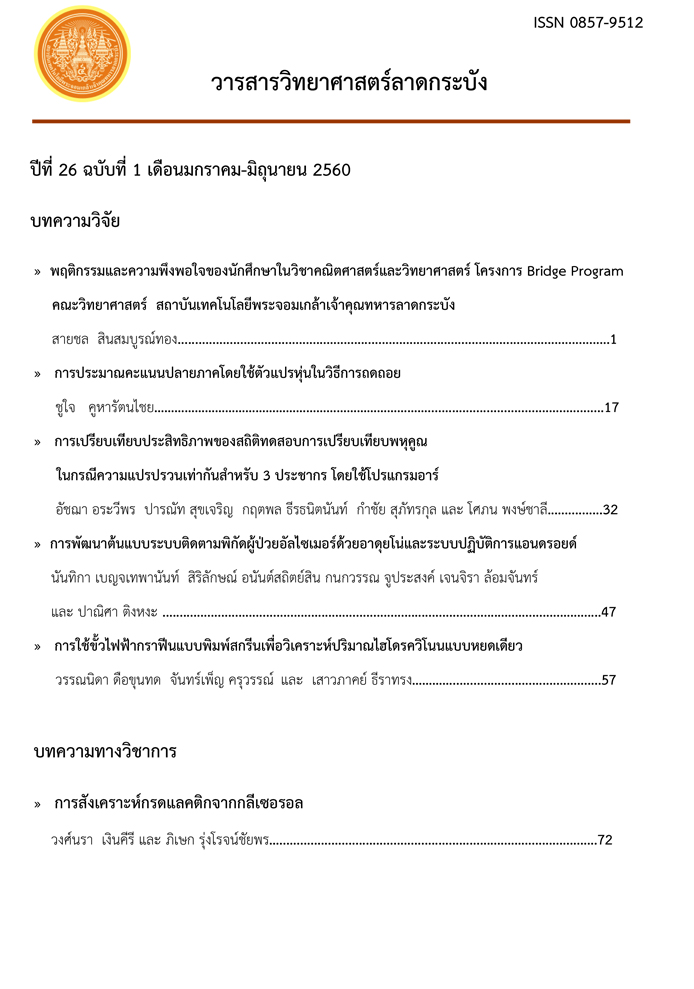การใช้ขั้วไฟฟ้ากราฟีนแบบพิมพ์สกรีนเพื่อวิเคราะห์ปริมาณไฮโดรควิโนน แบบหยดเดียว
Main Article Content
Abstract
บทคัดย่อ
งานวิจัยนี้ได้พัฒนาขั้วไฟฟ้ากราฟีนแบบพิมพ์สกรีน (SPGE) ขนาดเล็ก เพื่อวิเคราะห์หาปริมาณ
ไฮโดรควิโนนด้วยเทคนิคไซคลิกโวลแทมเมทรี ร่วมกับการวิเคราะห์แบบหยดเดียว (single drop analysis)
โดยใช้สารละลายฟอสเฟตบัฟเฟอร์ความเข้มข้น 0.1 โมลต่อลิตร พีเอช 7 เป็นสารละลายอิเล็กโทรไลต์
ในการวิเคราะห์ ทําการหยดไฮโดรควิโนนปริมาตร 60 ไมโครลิตร ลงบนขั้วไฟฟ้า จากนั้นทําการสแกน
ศักย์ไฟฟ้าในช่วง -0.8 ถึง 0.6 โวลต์ ด้วยอัตราการสแกน 100 มิลลิโวลต์ต่อวินาที จากผลการทดลองพบว่า
ค่ากระแสไฟฟ้าแคโทดิกของปฏิกิริยารีดักชันแปรผันตามความเข้มข้นไฮโดรควิโนน โดยให้ความเป็นเส้นตรง
อยู่ในช่วง 0.1 ถึง 5.0 มิลลิโมลต่อลิตร ขีดจํากัดต่ําสุดของการตรวจวัด (LOD) เท่ากับ 0.07 มิลลิโมลต่อลิตร
และส่วนเบี่ยงเบนมาตรฐานสัมพัทธ์ของการวัด (RSD) มีค่าต่ํากว่า 2.78 % เมื่อนําวิธีที่พัฒนาขึ้นนี้ไป
ตรวจวัดปริมาณไฮโดรควิโนนในตัวอย่างครีมไวเทนนิ่งให้ค่าร้อยละการคืนกลับ (recovery) อยู่ในช่วงที่
ยอมรับได้ (87-114%) และเมื่อนําผลการวิเคราะห์ของวิธี SPGE ที่พัฒนาขึ้น เปรียบเทียบกับผลที่ได้จาก
เทคนิคโครมาโทกราฟีของเหลวสมรรถนะสูง โดยใช้สถิติ paired t-test ที่ระดับความเชื่อมั่นร้อยละ 95
พบว่า ทั้งสองเทคนิคให้ผลที่ไม่แตกต่างกันอย่างมีนัยสําคัญ ขั้วไฟฟ้าที่พัฒนาขึ้นมีลักษณะเด่นคือ มีความ
น่าเชื่อถือ พกพาได้ และใช้ปริมาณสารตัวอย่างในการวิเคราะห์น้อย
คําสําคัญ : ไฮโดรควิโนน, ขั้วไฟฟ้ากราฟีนแบบพิมพ์สกรีน, ไซคลิกโวลแทมเมทรี, ครีมไวเทนนิ่ง
Abstract
A single drop analysis of hydroquinone using screen-printed graphene electrode
(SPGE) was developed. The electrochemical detection was based on cyclic voltammetry.
A 0.1 M phosphate buffer at pH 7 was employed as a supporting electrolyte. For analysis,
60 µL volume of hydroquinone was dropped onto the electrode. The potentials were
applied from -0.8 to 0.6 V with a scan rate of 100 mV s-1. Under the optimized condition, a
reduction peak current response for hydroquinone was linear in the range of 0.1 to 5.0
mM. The detection limit of 0.07 mM of hydroquinone was obtained. The relative standard
deviation (RSD) of measurement was less than 2.78 %. The developed method was
applied to determine hydroquinone in whitening creams. The obtained results were
validated with the results from the high performance liquid chromatography (HPLC).
Using the paired t-test at 95% confidence level, there was no significant difference
between two sets of results. The analytical recoveries were acceptable (87 – 114%). The
developed sensor has superior in terms of reliable, portable and low sample
consumption.
Keywords: Hydroquinone, Screen-printed graphene electrode (SPGE), Cyclic voltammetry, Whitening cream

